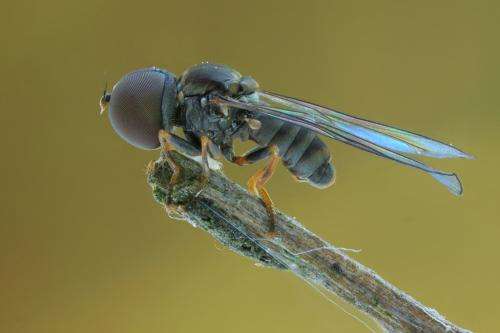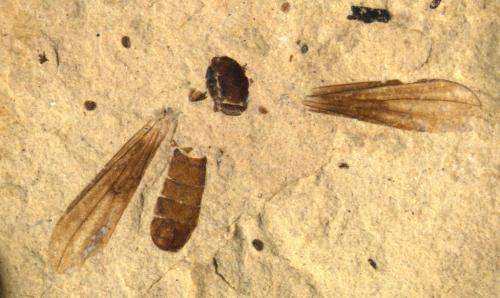Big-eyed fossil flies track major ecological revolution

(Phys.org) —Simon Fraser University's Bruce Archibald and Rolf Mathewes are part of a team of biologists, including Christian Kehlmaier from Germany's Senkenberg Natural History Collections, that has discovered three new, extinct fossil species of big-headed flies.
According to their research, published recently by The Canadian Entomologist, these fossils show their early evolution parallels an ecological revolution, one that formed the character of our modern natural communities.
The three new species of fossil big-headed flies are members of the living family Pipunculidae. One fossil, Metanephrocerus belgardeae, is well-enough preserved to name as a new species. It is named in honour of its finder, Azure Rain Belgarde, a student at the Paschal Sherman Indian School, who uncovered it on a field trip to the fossil deposits at Republic, Washington state.
The other two unnamed, more enigmatic species are described from less complete fossils uncovered at Quilchena in southern British Columbia.
"Big-headed flies are a group of bizarre insects whose round heads are almost entirely covered by their bulging compound eyes, which they use to hunt for mainly leafhoppers and planthoppers, renowned common garden insect pests," says Archibald.
"The newly discovered species were preserved in Eocene epoch fossil beds that are 49 million to 52 million years old, which is about 12 million to 15 million years after the extinction of the dinosaurs. This great extinction event also disrupted forests in which the dinosaurs had lived, with mostly low diversity and greatly disrupted food webs for millions of years."

By the time of these flies in the Eocene, however, forests had diversified again, but this time with many new kinds of flowering plants that are familiar to us today, such as birches, maples, and many others.
Along with these new, rich forests came an expanding diversity of pollinators and herbivorous insects, and with them, diversification of their insect predators, including these big-headed flies.
"With these new discoveries, we see that the early history of these oddly shaped insect predators provides a part of the puzzle revealing the broad ecological-evolutionary revolution of expanding predator-prey relationships and increasing biodiversity during the formation of new ecosystems," says Archibald.
Simon Fraser University is consistently ranked among Canada's top comprehensive universities and is one of the top 50 universities in the world under 50 years old. With campuses in Vancouver, Burnaby and Surrey, B.C., SFU engages actively with the community in its research and teaching, delivers almost 150 programs to more than 30,000 students, and has more than 125,000 alumni in 130 countries.
More information: Paper: journals.cambridge.org/action/ … e=online&aid=9137309
Provided by Simon Fraser University





















